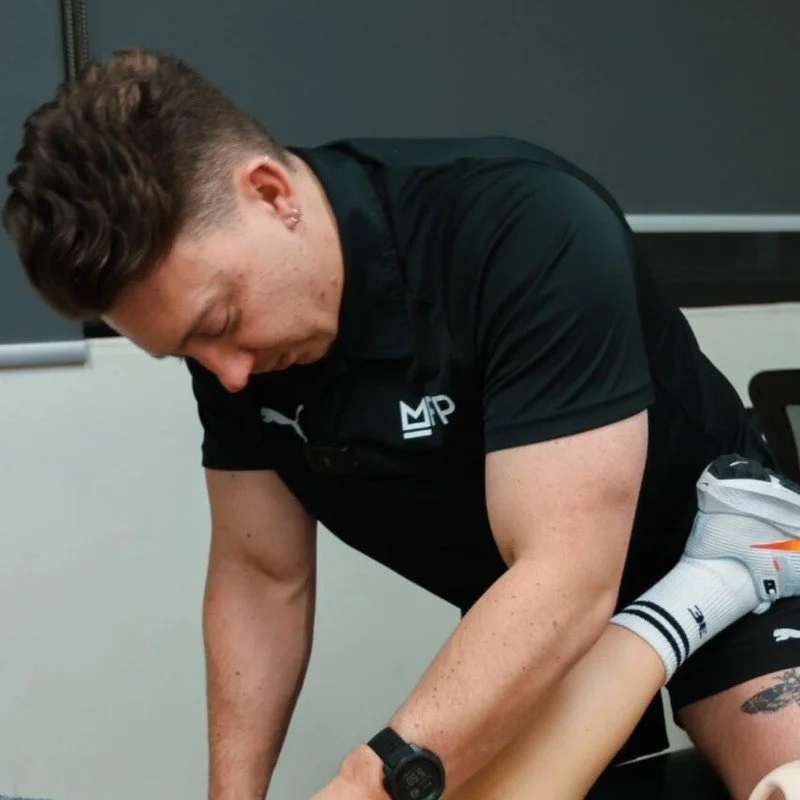Hip Physio Melbourne
Is Hip Pain Disrupting Your Life?
Can't walk without discomfort? Hip pain keeping you awake at night like those pesky neighbours that keep playing the Dandy Warhols? You're not alone. Hip pain affects thousands of Melburnians daily, but the good news is that with the right physiotherapy treatment, you can get back to living pain-free.
At Evolutio, our specialised hip physiotherapists in Melbourne have helped over 2,000 patients overcome hip pain and return to their active lifestyles. Whether you're dealing with acute injury or chronic hip problems, we're here to help.
Comprehensive Hip Pain Treatment in Melbourne
Why Choose Evolutio for Hip Physio?
Our Melbourne hip physiotherapy clinic offers evidence-based treatment that gets results:
Immediate pain relief techniques
Personalised treatment plans based on your specific condition
Advanced assessment technology for accurate diagnosis
Proven rehabilitation programs with 94% success rate
Same-day appointments available
"I couldn't believe the difference after just one session. The team at Evolutio not only relieved my hip pain but taught me how to prevent it from coming back." - Sarah M., Richmond
Book an appointment online now
Choose your Hip Physiotherapist
Andy
(Tuesday and Thursday arvo’s)
Phill Danzi
(On Saturdays only)
Catya
(Tuesday and Thursday arvo’s)
Hip Conditions We Treat
Common Hip Problems
Hip impingement syndrome
Hip bursitis and inflammation
Hip labral tears
Hip osteoarthritis
Piriformis syndrome
ITB syndrome
Post-surgical hip rehabilitation
Sports-related hip injuries
Our physiotherapists use evidence-based treatment approaches recommended by the Australian Physiotherapy Association to ensure you receive the highest standard of care.
Serving Melbourne's Hip Pain Sufferers
Richmond Hip Physio Services
Located in the heart of Melbourne, our Richmond clinic is easily accessible for residents across:
Richmond - Our main clinic location
South Yarra - 5 minutes from our practice
Prahran - Convenient public transport access
Collingwood - Short drive or tram ride
Fitzroy - Easy access via Bridge Road
Richmond Clinic Benefits:
Free parking available
Accessible via multiple tram lines
Extended hours for working professionals
Sports injury specialists on-site
Melbourne-Wide Hip Treatment
We also provide hip physiotherapy services throughout Melbourne, including:
CBD appointments for city workers
Home visit services for mobility-limited patients
Workplace ergonomic assessments
Our Hip Pain Treatment Process
1. Comprehensive Assessment (45 minutes)
Detailed pain history and lifestyle analysis
Movement screening using advanced diagnostic tools
Postural assessment and gait analysis
Strength and flexibility testing
2. Personalised Treatment Plan
Based on your assessment, we develop a targeted treatment plan that may include:
Manual therapy and joint mobilization
Dry needling for trigger point release
Exercise prescription and movement retraining
Pain management techniques
Activity modification guidance
3. Progressive Rehabilitation
Strength building exercises
Flexibility and mobility programs
Functional movement training
Return to sport/activity protocols
Research from the Journal of Hip Preservation Surgery shows that early physiotherapy intervention can reduce hip pain by up to 80% within 6-8 weeks.
Hip Pain Prevention & Self-Care
Daily Hip Care Tips
Maintain proper posture during sitting and standing
Regular stretching of hip flexors and glutes
Strengthen core muscles to support hip function
Avoid prolonged sitting - take breaks every 30 minutes
Wear supportive footwear to maintain proper alignment
When to Seek Hip Physio Treatment
Seek immediate assessment if you experience:
Sharp, stabbing hip pain
Pain that worsens with walking or climbing stairs
Hip stiffness lasting more than 30 minutes in the morning
Pain that interrupts your sleep
Reduced range of motion in your hip
Clicking, locking, or catching sensations
According to Arthritis Australia, early intervention is key to preventing chronic hip problems.
Advanced Hip Treatment Options
Specialised Techniques Available
Shockwave therapy for chronic hip pain
Clinical Pilates for core strengthening
Hydrotherapy in our heated pool
Dry needling and acupuncture
Ultrasound-guided injections (when appropriate)
Our sports physiotherapy team specialises in hip injuries common in:
Running and athletics
Football and soccer
Dancing and gymnastics
Cycling sports
Success Stories
Real Patient Outcomes
"After 6 months of hip pain that was affecting my running, the team at Evolutio had me back to marathon training in just 8 weeks. Their approach was thorough and the results speak for themselves." - Michael T., South Yarra
"I was considering hip surgery when I found Evolutio. Three months later, I'm pain-free and stronger than ever. I can't thank them enough." - Lisa K., Prahran
Frequently Asked Questions About Hip Physiotherapy
Q: How long does hip pain take to heal with physiotherapy?
A: Recovery time varies depending on the condition and severity. Acute hip pain often improves within 2-4 weeks, while chronic conditions may take 6-12 weeks. Our physiotherapists will provide a realistic timeline during your initial assessment.
Q: Can physiotherapy help avoid hip surgery?
A: In many cases, yes. Studies show that physiotherapy can be as effective as surgery for certain hip conditions, including hip impingement and mild arthritis. We work closely with orthopedic surgeons when surgery is necessary.
Q: What should I expect during my first hip physio appointment?
A: Your first appointment includes a comprehensive 45-minute assessment covering your pain history, movement analysis, and physical examination. You'll receive immediate pain relief techniques and a clear treatment plan.
Q: Do you bulk bill for hip physiotherapy?
A: Yes, we offer bulk billing options for eligible patients with valid referrals. We also accept private health insurance and provide HICAPS claiming. Learn more about our fees and billing.
Q: How often will I need hip physio sessions?
A: Initially, most patients benefit from 2-3 sessions per week. As you improve, this reduces to weekly sessions and eventually monthly maintenance visits. Your physiotherapist will adjust frequency based on your progress.
Q: Can I exercise with hip pain?
A: This depends on your specific condition. Some gentle exercises may help, while others could worsen your pain. Our physiotherapists will provide safe exercise guidelines and modify your fitness routine appropriately.
Q: What's the difference between hip pain and referred pain?
A: Hip pain originates from the hip joint itself, while referred pain comes from other areas like the lower back or pelvis. Our assessment can determine the true source of your pain for targeted treatment.
Q: Should I use heat or ice for hip pain?
A: Generally, ice is better for acute injuries (first 48-72 hours), while heat helps with chronic stiffness. However, the best approach depends on your specific condition. We'll provide personalised advice during your consultation.
Q: Can hip pain cause knee or back problems?
A: Absolutely. Hip dysfunction often leads to compensatory movements that stress the knee, lower back, and pelvis. Our treatment addresses these connected issues for comprehensive healing.
Q: What makes Evolutio different from other Melbourne physio clinics?
A: Our specialised focus on musculoskeletal conditions, advanced diagnostic equipment, and evidence-based treatment protocols sets us apart. Plus, our high success rates and patient satisfaction scores speak for themselves.
Book Your Hip Assessment Today
Don't let hip pain control your life any longer. Our Melbourne hip physiotherapy specialists are ready to help you get back to pain-free movement.
Contact Options:
Phone: Call us now for same-day appointments
Online Booking: Book your assessment online
Emergency Appointments: Available for acute hip injuries
Located in Richmond, Melbourne 11/3 Bromham Place, Richmond 3121
Insurance & Payment:
Bulk billing available for eligible patients
Private health insurance accepted
HICAPS claiming on-site
Payment plans available
Ready to start your recovery? Contact our team today or book your hip physio appointment online.
Evolutio is a registered physiotherapy practice serving Melbourne since 2013. Our practitioners are registered with AHPRA and members of the Australian Physiotherapy Association.







